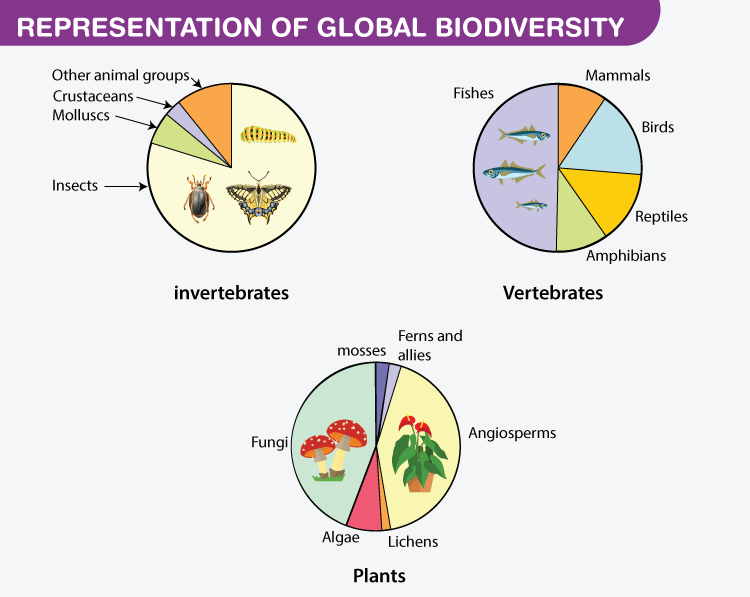The term “Biodiversity” refers to the heterogeneity present in the world or a habitat, ranging from macromolecules within the cells to biomes. Biodiversity comprises:
- Species diversity: Variety of species and abundance of species
- Genetic diversity: Genetic variability present within the species
- Ecological diversity: Ecosystem variety present within a geographical area
Download Complete Chapter Notes of Biodiversity and Conservation
Download Now
Table of Contents

What is Species Diversity?
“Species diversity is defined as the number of different species present in an ecosystem and relative abundance of each of those species.”
Diversity is greatest when all the species present are equally abundant in the area. There are two constituents of species diversity:
- Species richness: Number of different species present in an ecosystem. Tropical areas have greater species richness as the environment is conducive for a large number of species
- Species evenness: Relative abundance of individuals of each of those species. If the number of individuals within a species is fairly constant across communities, it is said to have a high evenness and if the number of individuals varies from species to species, it is said to have low evenness. High evenness leads to greater specific diversity
It is possible in an ecosystem to have high species richness, but low species evenness.
For example:
- In a forest, there may have a large number of different species (high species richness) but have only a few members of each species (low species evenness)
- In a forest, there may be only a few plant species (low species richness) but a large number of each species (high species evenness)
The species diversity varies in a different geographical location with tropics having highest and declines as we move towards poles. The most species-rich environments are tropical rainforests, coral reefs and ocean bottom zone.
Species richness increases with increasing explored area.
Also see: MCQs on Species Diversity
Importance of Species Diversity
In a healthy ecosystem, diverse and balanced number of species exist to maintain the balance of an ecosystem. In an ecosystem, all the species depend on each other directly or indirectly. So to make a more efficient, productive and sustainable ecosystem, it is important to maintain high species diversity.
- More diverse ecosystem tend to be more productive. E.g. the ecosystem with a great variety of producer species will produce large biomass to support a greater variety of consumer species
- Greater species richness and productivity makes an ecosystem more sustainable and stable
- More diverse the ecosystem, greater is the ability to withstand environmental stresses like drought or invasive infestations
- Species richness makes an ecosystem able to respond to any catastrophe
- In Species-rich communities, each species can use a different portion of resources available as per their requirement. E.g. plants with smaller roots can absorb water and minerals from shallow soil and plants with deeper roots can tap deeper soil
- Rich diversity is important for the survival of mankind
- Healthy biodiversity has innumerable benefits like nutrients storage and recycling, soil formation and protection from erosion, absorption of harmful gases, climate stability
- Humans get lots of product from nature like fruits, cereals, meat, wood, fibre, raisin, dyes, medicine, antibiotics, etc.
- Amazon forest is estimated to produce 20 percent of total oxygen in the earth’s atmosphere through photosynthesis
- Pollinators, symbiotic relationships, decomposers, each species perform a unique role, which is irreplaceable
- Diversity in large numbers help in large scale interaction among organisms such as in the food web
- In the nitrogen cycle, bacteria, plants have a crucial relationship, earthworms contribute to soil fertility
- Apart from these, there are other benefits such as recreation and tourism, education and research
Each species plays an important role in an ecosystem. The role that a species plays in its ecosystem is known as its “ecological niche”. Species can be broadly divided into generalist and specialist species.
- Generalist species: They have broad niches. These can live in many places and can eat a variety of foods. They can thrive in rapidly changing environmental conditions. E.g. cockroaches, rats, mice, flies, white-tailed deer, raccoons, humans, etc.
- Specialist species: They have a narrow niche, found in only one type of habitat and feed on a few types of food. They are more prone to disturbances in the environmental condition and cannot tolerate the change and environmental stress. In the tropical rain forests where environmental conditions are fairly constant, specialist species hold an advantage as they have fewer competitors for the resources. E.g. the giant panda of China is endangered because of low reproductive rate, disturbances in its habitat and specific diet mostly bamboo. Tiger salamanders breed in fishless ponds, shorebirds that feed on crustaceans tend to live on sandy beaches and adjoining coastal wetlands.
- Native species: Species that normally live and thrive in a particular ecosystem.
- Non-native species (invasive or alien species): Species that migrate deliberately or accidentally to an ecosystem. They can spread rapidly if they find a favourable niche. Invasive species compete with other species for food and habitat. If the indigenous species are unable to compete, they are forced to leave or die.
- Indicator species: These serve as biological smoke alarms. These species provide early warnings of damage to an ecosystem. E.g. presence of trout species is an indicator of the water quality as they need clean water with high levels of dissolved oxygen to thrive, birds are an excellent biological indicator of their habitat loss and fragmentation and use of chemical pesticides. Butterflies are also a good indicator species as their association with various plant species makes them vulnerable to their habitat loss and fragmentation. Coal miners used canaries as an indicator of the poisonous and explosive gases present in the mine.
- Keystone species: They play an important role in maintaining species diversity and integrity of an ecosystem. They have a high impact on the types and abundance of species in an ecosystem. These species play several critical roles in helping certain species (e.g. role in pollination like bees, butterflies) to sustain as well as check the overpopulation of other species to become overly dominant (e.g. top predators like a lion, shark, wolf, etc. ). E.g. if predatory starfish was removed from an ecosystem, it resulted in different species of mussels to outcompete other species and reducing species diversity
- Foundation species: They play an important role in creating and enhancing habitats. E.g. Elephants push over or uproot trees to open forest in grasslands and woodlands of Africa, promoting the growth of grass and other foliage required for small grazing species like an antelope
Examples of the ecosystem with high Species Diversity
- Tropical Rainforests: They contain half of the world’s species. There are about 5-10 million insect species present. 40% of the world’s 2,75,000 species of flowering plants are present in the tropical regions. 30% of total bird species are present in tropical forests. The species richness of tropical forests is mostly due to relatively constant environmental conditions.
- Coral Reefs: Colonies of tiny coral animals build the large coral reefs ecosystem. The clarity of the water in the coral reef systems allow the sunlight to penetrate deep, resulting in the high level of photosynthesis in the algae present inside the coral. Adaptation to various disturbances and niche specialisation gives rise to species richness.
The Great Barrier Reef of Australia is the world’s largest coral reef with an area of 349,000Km2. It contains about 400 species of coral, 1500 species of fish, 4000 species of molluscs and 6 species of turtles. It provides a breeding site for around 250 species of birds. It covers only 0.1% of the ocean but has about 8% of the world’s fish species. There are thousands of species which are yet to be discovered and described.
Threats to species diversity
The world is facing an accelerated rate of extinction of species largely due to human activities. The four major causes of loss of diversity are known as “The Evil Quartet”.
These are:
- Habitat Loss and Fragmentation: Due to pollution, urbanisation and various other human activities, habitat loss and fragmentation is a major cause of loss in species diversity and driving plants and animals extinct. E.g.
- Amazon rainforest (lungs of the planet), which is a house to millions of species are being cut and cleared for various purposes
- Tropical rainforest, which once covered 14 per cent of landmass, is no more than 6 percent now
- Over Exploitation: Over-exploitation of natural resources leads to the extinction of many species. E.g. Steller’s sea cow, the passenger pigeon, many marine fishes are overharvested
- Alien species invasions: When alien species are introduced deliberately or unintentionally, some of them become invasive, leading to the extinction of indigenous species. E.g.
- Extinction of cichlid fish in Lake Victoria due to the introduction of the Nile perch
- Illegal introduction of the African catfish is a threat to indigenous catfishes in rivers
- Co-extinctions: When a species becomes extinct, the species that are associated with it also becomes extinct. E.g.
- When a host fish goes extinct, the parasite also goes extinct
- Mutualism like a plant-pollinator, where extinction of one species leads to the extinction of other species too
Also explore:
Conservation of Species Diversity
Each species has an important role to play in an ecosystem. It is important to conserve diversity because once extinct, we can not get it back. There are many ways to conserve biodiversity:
- Biodiversity rich regions are protected as biosphere reserves, national parks and sanctuaries i.e. called in-situ conservation. Protecting Sunderbans for many endangered species like the royal Bengal tiger, olive ridley sea turtles, mangrove species etc.
- Biodiversity hotspots have been identified, which have high species richness. Total of 34 hotspots are identified globally e.g. Western ghats and Sri Lanka, Indo-Burma and Himalaya are rich biodiversity regions of our country
- India has a tradition of protecting nature. In many cultures, trees and wildlife are given full protection e.g. sacred groves
- Ex-situ conversation, where threatened and endangered species are identified, taken out and given full protection and kept in special reserves like botanical gardens, wildlife safari, etc.
- Gametes of threatened species are preserved by cryopreservation techniques
- Seeds of commercially important plants are kept in the seed bank
Frequently Asked Questions on What is Species Diversity?
What is The Definition of Species Diversity?
Species diversity is the number of species and abundance of each species dwelling in a specific region.
What Causes Species Diversity?
Species diversity is caused by evolution. A region becomes diverse with the evolution of different species in an area.
What is The Example of Species Diversity?
Species diversity is the measure of biological diversity observed in a particular ecological community indicating a number of species or species richness in an ecological community.
Example – woodland forest comprising 4-5 different species of trees. Tens of hundreds of fish species, coral and crustaceans found in a specific reef etc.
What are the 2 Components of Species Diversity?
Species richness and Species evenness.
Species richness – Number of different species present in an ecosystem.
Species evenness: Relative abundance of individuals of each of those species. High evenness leads to greater specific diversity
What Would Reduce Species Diversity?
Species diversity mainly reduces due to human activities. There are mainly 4 causes of loss of diversity known as The Evil Quartet which are – Alien species invasions, Habitat Loss and Fragmentation, Overexploitation, and co-extinctions.
How do human activities affect species diversity?
Also Check:
NEET Flashcards: Organisms And Populations
NEET Flashcards: Biodiversity And Conservation
NEET Flashcards: Environmental Issues
Recommended Video:


Good and quality material
Describe the Measurement techniques of species diversity
Measure of species diversity can be grouped into the following – Species richness indices, Species proportional abundance based indices, Species abundance models, the Shannon Index and the Simpson index. These are widely still used in ecology, despite of valid critiques leveled against them.